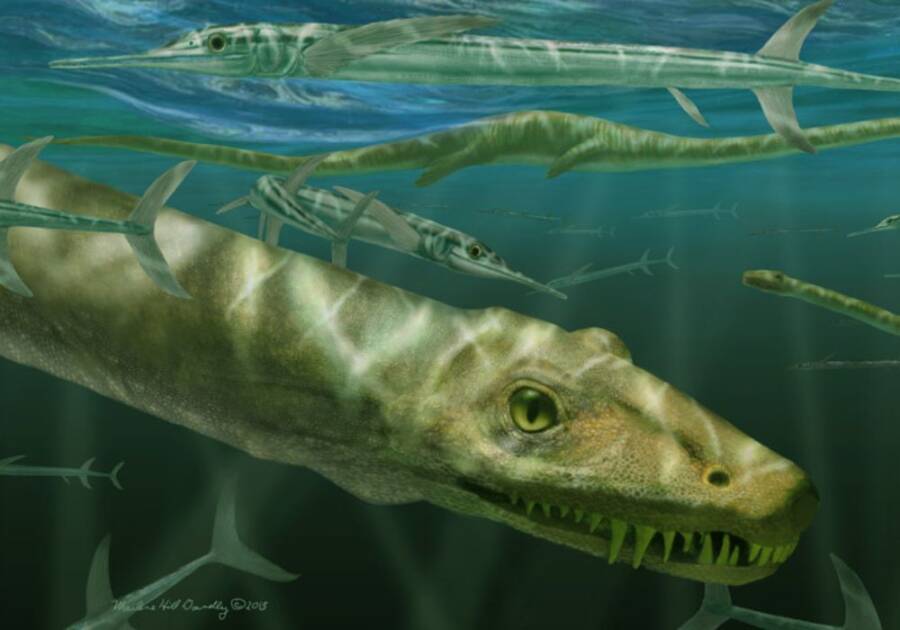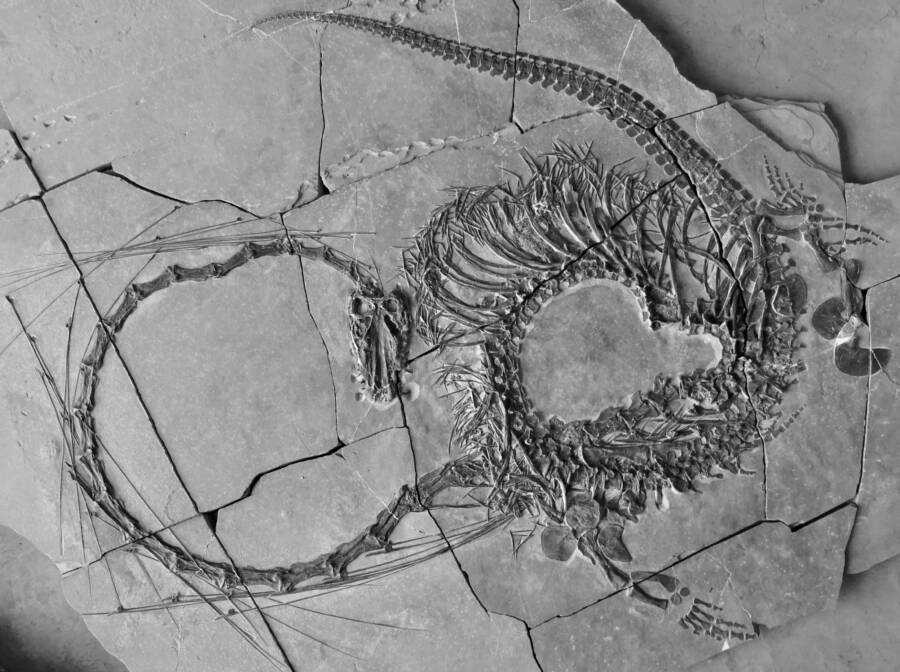Dinocephalosaurus orientalis was an aquatic reptile that roamed the waters of China during the early Triassic period 240 million years ago.

Marlene Donelly/National Museums ScotlandAn illustration of Dinocephalosaurus orientalis swimming with prehistoric fish.
A team of international scientists recently made an astounding discovery of a 240-million-year-old reptile fossil in southern China. The fossil, which belongs to the aquatic Dinocephalosaurus orientalis, resembles a dragon straight from the pages of Chinese mythology.
Scientists originally identified Dinocephalosaurus orientalis back in 2003. In the following years, paleontologists discovered additional fragments of the prehistoric reptile species but were unable to piece together a full recreation. This recent discovery marks the first time scientists have unearthed a completed skeleton of the creature.
What Did “Dinocephalosaurus Orientalis” Look Like?
According to a study published in Earth and Environmental Science: Transactions of the Royal Society of Edinburgh, the Dinocephalosaurus orientalis was a 16-foot-long reptile that prowled the waters of Triassic China. While similar to other aquatic reptiles of that period, Dinocephalosaurus orientalis stands out for its remarkably long neck.

National Museums ScotlandThe fossilized remains of the Dinocephalosaurus orientalis, the prehistoric reptile resembling the dragons of Chinese mythology.
With 32 neck vertebrae, Dinocephalosaurus orientalis would have appeared more snake-like than its counterparts, giving it a look that distinctly resembles a dragon from Chinese mythology.
“It is yet one more example of the weird and wonderful world of the Triassic that continues to baffle paleontologists. We are certain that it will capture imaginations across the globe due to its striking appearance, reminiscent of the long and snake-like, mythical Chinese Dragon,” Nick Fraser, Keeper of Natural Sciences at National Museums Scotland, stated in the museum’s press release.
What Scientists Are Learning From This “Chinese Dragon”
Alongside its elongated neck, the Dinocephalosaurus orientalis had flippered limbs that allowed it to thrive in its aquatic environment. Interestingly, the research team also identified four “exquisitely preserved” fish in the creature’s abdomen.

National Museums ScotlandFossilized fish remains discovered in the reptile’s abdominal region.
Although the international research team has studied the Dinocephalosaurus orientalis for more than 10 years, they are optimistic that the full skeleton will reveal greater information about the creature, its environment, and the era it belonged to.
Dr. Stephan Spiekman, a postdoctoral researcher at the Stuttgart State Museum of Natural History in Germany, told National Museums Scotland that he was hopeful for further findings.
“As an early-career researcher, it has been an incredible experience to contribute to these significant findings. We hope that our future research will help us understand more about the evolution of this group of animals, and particularly how the elongated neck functioned.”
For now, the research team celebrates their findings and the extensive collaboration it took to uncover them.
“This has been an international effort. Working together with colleagues from the United States of America, the United Kingdom, and Europe, we used newly discovered specimens housed at the Chinese Academy of Sciences to build on our existing knowledge of this animal,” Professor Li Chun from the Institute of Vertebrate Palaeontology and Palaeoanthropology stated in National Museums Scotland’s press release.
“Among all of the extraordinary finds we have made in the Triassic of Guizhou Province,” Li Chun said, “Dinocephalosaurus probably stands out as the most remarkable.”
After reading about the discovery of this Dinocephalosaurus orientalis fossil, learn all about the purussaurus, the powerful prehistoric crocodile. Then, explore the question of what really killed the dinosaurs.





